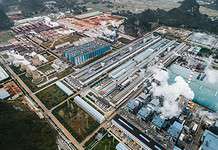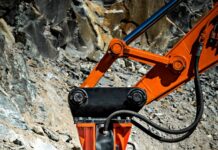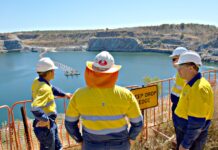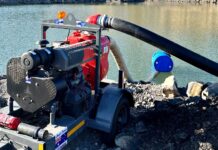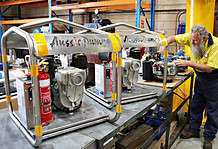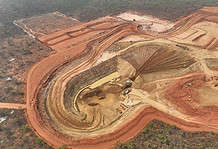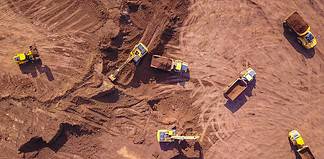All images: Newcrest.
BY ELIZABETH FABRI
ON the back of one of its most eventful years to date, including an earthquake at its Cadia operation in April, Newcrest Mining remains in a comfortable position – on track to achieve its annual production guidance for the fourth consecutive year while advancing greenfields exploration overseas.
The Newcrest executive team made some big decisions in 2016. The global gold miner signed an agreement to sell its 50 per cent stake in its PNG Hidden Valley facility at a $10m loss, let go of its Marsden copper gold project in NSW, put its Ridgeway underground mine at Cadia into care and maintenance, and welcomed a new investment to its portfolio — a stake in SolGold’s up-and-coming North West Ecuador project.
Yet despite transforming its portfolio, the miner successfully ramped up production at its remaining operations, and achieved gold production of 1.23moz for the first half of the fiscal period at a group all-in sustaining cost of $770/oz, and a further 599,000oz in the March quarter. Newcrest gold production was also slightly lower than the prior quarter, primarily due to heavy rainfall at Telfer.
In April, a magnitude 4.3 earthquake near its Cadia operation put a dent in production, forcing the mine to lower production over the next few months.
Cadia updates
In the December quarter, Newcrest achieved a record plant throughput of 26.4mtpa at its $2 billion Cadia Valley Operation (CVO) in NSW, which exceeded nameplate capacity.
The increase mill throughput was a 6 per cent increase on the prior quarter and an important milestone for Newcrest as it worked towards its goal of reaching 28mtpa.
The first half of the financial year also saw the undercut level at Panel Cave 2 (PC2) completed, and drawrate increase to 4.2mt.
“PC2 footprint development is progressing well, with undercutting completed during the quarter and the firing of all drawbells remaining on track to be completed by the end of FY17,” Newcrest stated.
“Work continued on the construction of the conveying and crushing systems between Concentrator 1 and Concentrator 2.”
In the March quarter, gold production lowered due to reduced ore feed with the last of the Ridgeway stockpile contents consumed.
“Production from PC1 was restricted as a further one-and-a-half drives were excluded from production as a result of the interaction between PC1 and PC2 (there are now three and half drives closed to production),” Newcrest stated.
“During the March quarter, all underground mining was suspended for a week to accommodate the first ever, full belt change of one of the main underground decline conveyors.”
Newcrest also continued to progress its prefeasibility study (PFS) on a future plant expansion.
However on 14 April, a large seismic event in the region, forced the mine to conduct an inspection of all mine accesses to deem these safe for personnel.
The mine was placed under a prohibition notice, which included the cleanup of access drives and the extraction level of Panel Cave 1; rehabilitation of damaged ground-support; testing of critical mine infrastructure and the materials handling system; and the finalisation of a recommencement management plan.
On 27 April, Newcrest confirmed the mine still remained subject to the prohibition notice and the inspection of Panel Cave 1 had been completed.
“There has been damage identified to the crusher chamber area and extraction drives,” the company stated. Work continues on quantifying the remediation and enhancement work where required in specific areas prior to recommencement of mining. “Newcrest will provide a definitive estimate of the timeline for the recommencement of mining in PC1 once confirmed.”
The inspection at Panel Cave 2 had also been completed, with the cleaning of access drives well advanced.
“Newcrest has temporarily increased the number of jumbo drills (from 2 to 6) to undertake this work safely and efficiently,” it said.
“The expected duration of ground support work in PC2 is in the order of eight-10 weeks.
“Upon completion of this ground support work it is currently expected that PC2 mine production will recommence early in FY18.”
On 18 April the company said Cadia was not expected to meet its production guidance for FY17, but it was too early to be definitive of the earthquake’s impact.
Telfer progress
Newcrest’s Telfer mine in the East Pilbara region of WA remained a “consistent performer”.
In the first half of FY17, the mine produced 222,000oz of gold while expanding its search for additional near-mine deposits through a regional seismic survey.
Gold production in the December quarter was higher than the prior quarter due to an increase in grade and recovery, which offset the decrease in tonnes processed.
“Milled tonnes decreased as a result of an extended planned shutdown of Train 1 and an increase in unplanned downtime events,” the company stated.
“AISC per ounce in the December quarter decreased primarily due to higher by-product credits as a result of an increase in copper produced (related to the higher proportion of underground ore feed) and higher copper prices.
“During January, Telfer experienced significant rainfall which has resulted in the temporary flooding of the West Dome pit, some production restrictions in the Main Dome Pit and short-term plant outages.”
Despite the January interruptions, Newcrest was confident Telfer would meet FY17 guidance.

Lihir upgrades
Overseas, Newcrest’s Lihir mine in PNG was performing well, generating $123m of free cash flow (before tax) in the first half of FY17.
The company had ambitious plans for the site, announcing a new sustainable mill throughput target of 14mtpa last November; a goal it hoped to achieve by the end of December 2017.
Newcrest was not far off from this target, after achieving an annualised mill throughput rate of 13mtpa in December last year.
The team were also running project and studies in parallel to increase this further to an impressive 17mtpa.
As a result, throughout the December quarter the mine produced 10 per cent more gold with higher mill and autoclave throughput, and improved recovery, with increased gold production in the March quarter.
“Gold production in the March quarter was up 1 per cent as lower milling throughput was offset by higher head grade and slightly higher recovery rates,” Newcrest stated.
Furthermore, in March this year Newcrest entered a partnership with Telstra to deliver O3b high-speed broadband to the site; a first for a gold mine in the southern hemisphere.
The high-speed connection would be achieved through a new 100 megabits per second satellite link to Lihir, increasing bandwidth to the site by more than 600 per cent.
“As well as enabling better IT and digital solutions for our operation, the new link will help to make Lihir a better place to work and live for our workforce,” Newcrest chief information officer Gavin Wood said.
Exploration opportunities
Greenfields and brownfields exploration continues to be a key area of focus for Newcrest.
In the first half of FY17, exploration expenditure totalled $23m, which was a 15 per cent increase on the previous period.
The increased spend reflected Newcrest’s growing portfolio of strategic partnerships, investments and farm-in arrangements across the Asia-Pacific, West Africa and the Americas.
On 6 November, Newcrest announced it had entered an alliance with PT ANTAM to begin gold and copper exploration in several zones in West Java, East Java, South Sumatera, Nusa Tenggara, North Sulawesi, Halmahera and Mollucas Islands.
Under the deal, if projects of merit were identified, both parties would pursue these through separate JV arrangements.
Newcrest’s chief development officer Michael Nossal said the company had a proud exploration and operating history in Indonesia and long and successful working relationship with ANTAM in Indonesia through PT Nusa Halmahera Minerals (PTNHM), which managed the Gosowong gold mine.
“We are hopeful that this new agreement with ANTAM will result in opportunities that will allow Newcrest and ANTAM to grow their businesses in the country,” Mr Nossal said.
A week later, Newcrest also announced it had signed a heads of agreement with Randgold Resources to establish an exploration JV to search for projects of scale in southeast Côte d’Ivoire in West Africa.
Randgold would manage the exploration program and have operating status on any prospective mines that enter development.
“Randgold have proven their ability to successfully explore and operate in Africa over many years,” Mr Nossal said.
“Combining this with our own experienced West African exploration team to apply the best thinking from each group will provide a strong competitive edge in what we consider to be a prospective part of the country.”
Newcrest has also entered into an option and farm-in agreement with St Barbara Limited for exploration works on Tatua Island and Big Tabar Island in PNG, and with Rio de Oro for the Pedernales epithermal/porphyry project in northern Argentina.
On the brownfields side, Newcrest continued to advance exploration drilling at Gosowong, Telfer, Cadia and Bonikro.
Outlook
Following the earthquake at Cadia in April, Newcrest mining announced group gold production for the financial year would sit at the lower end of its FY17 guidance of between 2.35moz and 2.60moz gold and between 80,000t and 90,000t copper.
“FY17 Group gold production is expected to be around the bottom end of the guidance range,” Newcrest managing director and chief executive Sandeep Biswas said.
“Due to the recent seismic event, Cadia will not meet its production guidance for FY17.
“Telfer production is expected to be around the bottom end of its FY17 range while Gosowong production is expected to exceed its FY17 guidance range.”




